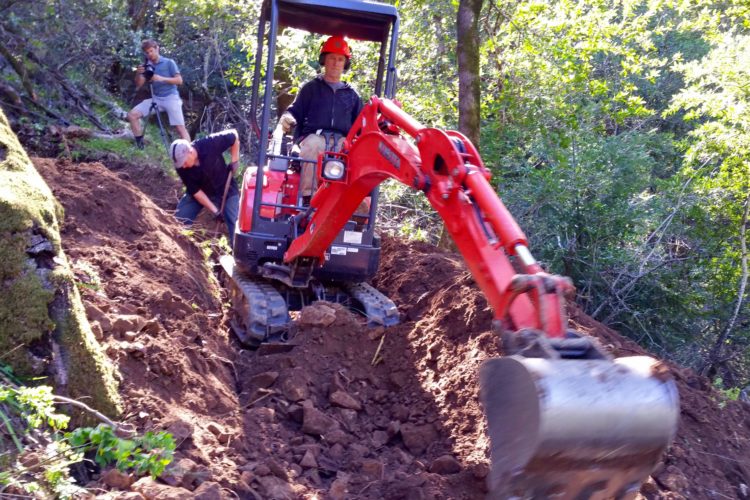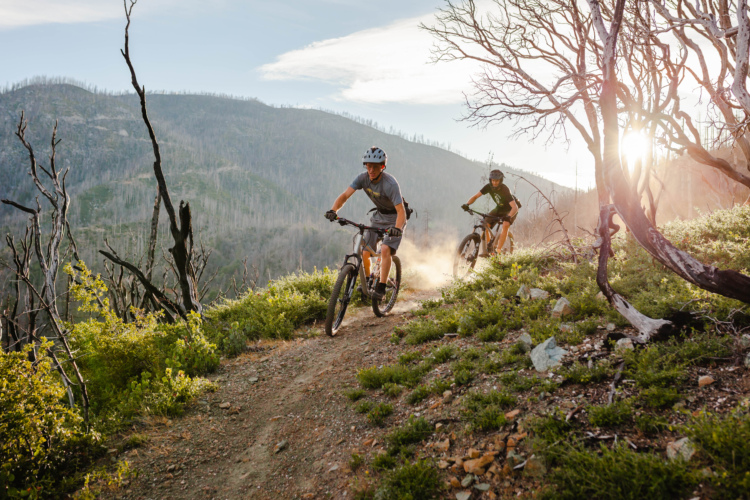
Perhaps now more than ever, local bike trails are in high demand. In many parts of the world, publicly-accessible singletrack doesn’t currently exist, and where it does there’s almost always an appetite for more trails.
One of the most frequent questions Singletracks gets via email is a seemingly foundational one: How do I get mountain bike trails built in my area? To answer this, we reached out to trail building and advocacy professionals at both the local and national level to put together a basic outline of the process. Every community is different, so these steps are meant to be generally applicable, and cannot specifically address all the potential challenges and considerations for every project.
Another thing to note is that this process isn’t necessarily linear or chronological. Decisions about things like trail design and fundraising may need to be revisited once construction actually begins. Or, permission might be contingent on the formation of a non-profit to manage the project. With that in mind, let’s begin!

Get help from others
Heading into the woods with a shovel may seem like the most logical first step to building a trail, but there’s actually a lot of planning that needs to happen before any dirt is moved. Even the dirt moving is a bigger job than most realize, so getting help is the first order of business. It’s generally easy to find like-minded individuals in the community through social media who are willing to support a trail project.
Eleanor Blick from IMBA says groups tend to form for one of two reasons. “There’s usually a need for trails or a threat to trails.”
For many groups, a bike ban can be the catalyst for forming. MTB Atlanta Executive Director Brett Davidson tells me the group that eventually became the Southern Off Road-Bicycle Association (SORBA) formed in the late 1980s to advocate for access after bikes were banned from the trails at Kennesaw Mountain just north of Atlanta. The International Mountain Bike Association (IMBA) got its start at around the same time in Northern California in response to trail closures there.
Many groups are formed in response to a specific trail building opportunity. Another Atlanta-area club — SORBA Woodstock — got its official start after volunteers started building trails at Blankets Creek and realized they needed to formalize their association to ensure the trails were well built and maintained.
Scott Linnenburger, who helped start the IMBA Trail Solutions program and is now a principal at trail consultancy group Kay-Linn Enterprises, says he gets asked the question about how to get trails built a lot.
“I would say 50% of the time it’s coming from a really avid [rider], like a 15- to 19-year-old.”
While younger riders are often the first and most enthusiastic “trail champions” to identify the need to organize and build, forming a diverse group of supporters can be advantageous. Retirees can be enlisted to press local officials on approvals, parents can use their connections for fundraising, and younger riders with ample stoke can provide the muscle and vision to create fun and progressive trails.

Choose your group name wisely
Once a core group is formed, even if it’s initially an informal one, choosing a group name is important. Many of the more established mountain bike clubs and advocacy groups include the word bike or bicycle in their name, but newer groups are finding that a different approach can open even more doors, more quickly. Greg Williams of the Sierra Buttes Trail Stewardship in northern California shared his thoughts on naming in a podcast interview.
“You know in hindsight [choosing Sierra Buttes Trail Stewardship as our group name] was probably one of the best decisions we ever made. When we were sitting down, and writing our first grant, and it was like ‘What are we going to call this thing?’ We were a group of mountain bikers, and dirt bikers, and so it was like, ‘are we the Downieville mountain bike organization?’ In hindsight thank goodness we really keyed into just trail stewardship [because] it’s opened a lot of doors for us, especially when we partner with land managers. [We are] able to represent a community and not a particular user group.”
Mat Stanke of the Clinch Valley Trail Alliance (CVTA) in Tennessee says his local club found similar success thanks in part to the group’s name.
“We set ourselves up to be a little different than most IMBA or SORBA clubs. In our mission statement, apart from growing our community and the next generation, we’re a hiking, biking, trail running, dog walking, ‘we don’t care who you are as long as you want to go play in the woods on trails’ [group].” Broadening their appeal can be helpful, he says.
“We have a little more inclusive focus when we’re doing building and community outreach and fundraising.”
Identify a potential location (or three)
Chances are local riders already have an idea about where they would like to build a trail — or they may be riding there already, albeit in an unofficial capacity. The ultimate goal for any trail project is to gain permission from the owner or land manager to access and create or maintain trails on the property. Of course there is no guarantee that permission will be granted, so it’s good to have options.
Stanke of the CVTA shared that his group once attempted to launch two different trail projects at around the same time, and ended up using neighborhood opposition to one of the projects to increase support for the other.
“[The opposition group] message was, ‘you already have Haw Ridge, why don’t you build more trails [over there].’ And we effectively said, yeah that’s a great idea.” Ultimately the CVTA built a skills area called the Dirt Lab with approvals coming relatively swiftly.
SORBA Woodstock found itself in a similar situation, at least as the club’s origin story goes. A bike access issue at Boling Park led the Army Corps of Engineers to suggest bikers build trails at Blankets Creek instead.
Presenting multiple site options shows bikers are flexible and open to compromise, and it can make for a stronger negotiating position.
Planning
At this stage it’s a good idea to have a rough idea of the scope of the proposed trail project based on the site or sites that have been identified, though it’s probably not possible to have the plan fully fleshed out yet. Knowing the approximate length of the proposed trail can be used to come up with a rough estimate for funding and volunteer requirements, though a more detailed plan will be necessary later in the process. Some agencies may require more detailed plans than others before granting approval.

Permission
Depending on who owns or manages the land where trails are proposed, the process for getting approvals can vary widely. For government owned or managed land, approvals at the city or county level may be quicker or easier than at the state or federal levels where there are more stakeholders involved. A good place to start is to contact your representative to find out who the decision makers are, and what the process looks like for that particular agency.
“The relationship between the project champions and the agency or land manager can help set the tone for the project at any level,” says Blick.
“Each agency—local to federal—is going to have its own approval process to navigate. State and Federal lands often have a longer administrative process, while municipal and county lands tend to require more community or neighborhood support and might have more liability concerns.”
Working with a private landowner may seem easier since it often involves convincing a single family or an individual, though there are still a number of potential hurdles that will need to be cleared. It helps to be organized, professional, and respectful in all communication along the way. Ultimately it’s up to the landowner to give permission, so be prepared to address their concerns about things like liability and stewardship, and ultimately respect their decisions either way.
Funding: How much do we need, and how do we get it?
Funding considerations should be a part of any trail project, ideally beginning early in the process. For new groups, and those with limited funds, utilizing volunteers can minimize costs.
“Especially on a small local project, where you’re probably looking at something that’s not going to receive a lot of funding, or there’s not a lot of funding available, [volunteers are] still the best way to get things done a lot of the time,” says Linnenburger.
His rule of thumb, generally, is to expect one volunteer to be able to build ten feet of hand-cut trail per hour. That works out to 528 hours (about 66, 8-hour days) for one person to build a mile of trail by hand. With 100 volunteers, that works out to a single 5-hour work day to clear the same distance.
But having a large volunteer force might not be enough. Davidson from MTB Atlanta says that they log more than 4,000 volunteer hours a year and it can still be challenging to keep up with maintenance on some trails.
For larger build projects, and even medium-sized ones, groups will likely need to access significant funding. Stanke mentioned that his club initially underestimated the cost to build a pump track professionally by tens of thousands of dollars.

“If it is more of a municipal or county or state level kind of project, that’s where I really see the utility of volunteers starts to decrease,” says Linnenburger. “As funding, availability, and levels of bureaucracy increase, that’s when it really starts to make sense to [utilize] professionals, from the master planning and site design through the construction […].”
The professionals we spoke with said to budget around $5 per foot of trail (that works out to a little over $25,000 per mile) when hiring trail builders. Of course the cost to build can vary depending on conditions, and the type of trail being built. Flow trails, for example, might cost closer to $7-10 per foot. Another thing to keep in mind is that many experienced trail builders book their time more than a year in advance, and there’s currently a project backlog due to Covid and increased demand for new trails.
The Professional Trail Builders Association (PTBA) maintains a directory of member companies and has tips for writing bid requests and contracts. Executive Director Aaryn Kay tell us, “In 2020 alone, PTBA member companies built more than 1,500 miles of trail.”
MTB Atlanta offers a good example for local clubs seeking funding. As a part of SORBA, it’s not a huge club but they have been successful raising money from multiple sources. Of course member dues are a start, but Davidson recommends seeking grants from government sources like RTP and LWCF and initiatives like the Santa Cruz PayDirt and Specialized Soil Searching programs. IMBA has two programs — Trail Accelerator grants and Dig In — that can help too. State and local governments may also make funding available through special retail or lodging tax programs that earmark funds for recreation.
Besides grants, online crowdfunding, individual and corporate donations, and fundraisers are options as well. Some groups have even found creative ways to access funding meant for loosely-related goals like improving water quality or public health.

Design and build
This is the stage where many are tempted to start, and it’s certainly the most visible of the three main stages. One last step before putting snipper to vine or shovel to dirt is to establish the trail route within the designated area. Generally, it’s best to both walk the land and consult maps and satellite images to create the best layout.
Linnenburger of Kay-Linn Enterprises says, “Folks that know their local terrain can have a pretty good idea when they start kind of laying it out on a map. And then they could go and double check that by wandering around and seeing, ‘does a stream really go through here, or does it just show a stream on the map that kind of peters out at a higher landscape?’ But you know, generally laying trails out in the way that the IMBA Trail Solutions book goes about it is still, certainly for volunteers, the best way to go about it.”
The IMBA Trail Solutions book is an excellent resource for anyone who is new to designing or building trails, and IMBA sells it online through Amazon. The book is broken up into sections with headings like Partnerships, Construction, and Maintenance and covers not just building techniques but also topics like getting permission and understanding the various types of stakeholders in trail projects.

Shovel time
It’s finally time to get dirty. As mentioned above, there’s a lot of labor involved in building a new trail, but for those willing to put in the effort, the build stage is relatively straightforward. Again, it’s highly recommended that organizers pick up a copy of IMBA’s Guide to Building Sweet Singletrack to keep volunteers and builders on track. The book covers everything in this article — and more — and in much finer detail.
“When we wrote that [book] it was it was made for [smaller] groups, the single person working in their backyard, the local club, to give them those links of understanding of, you know, if you follow these steps, you can get a decent product that’s going to last. And it’s not going to be something that whatever government entity you’re working for is going to look at it in five years and say, ‘well, that was a total mistake.'”




















0 Comments